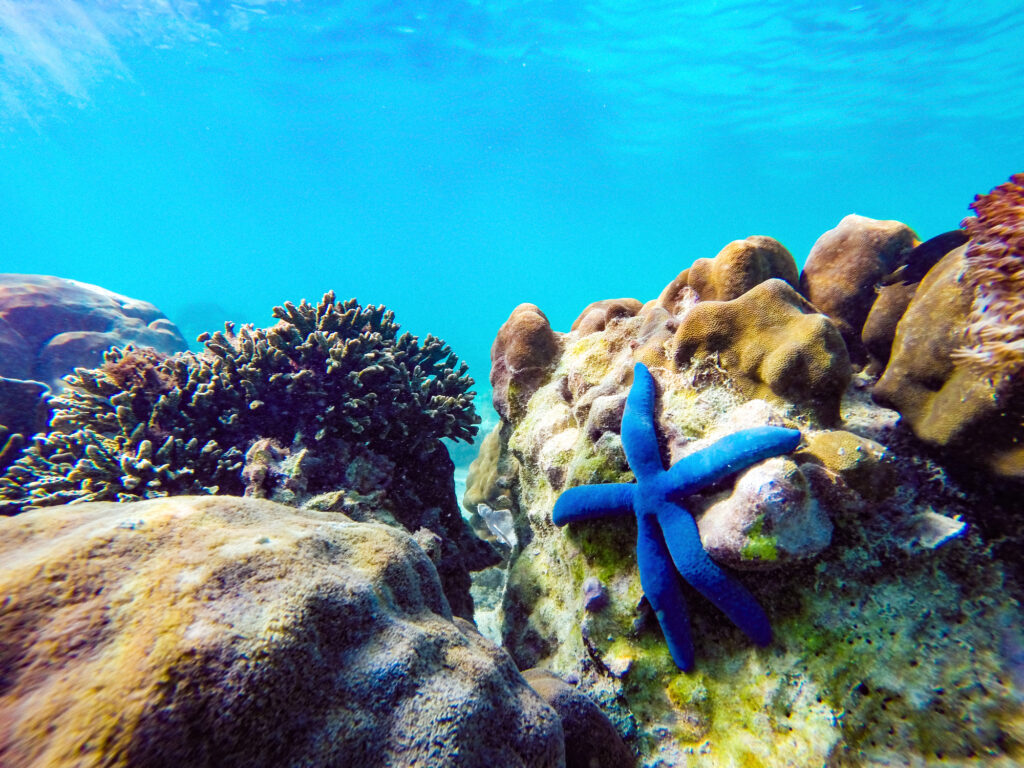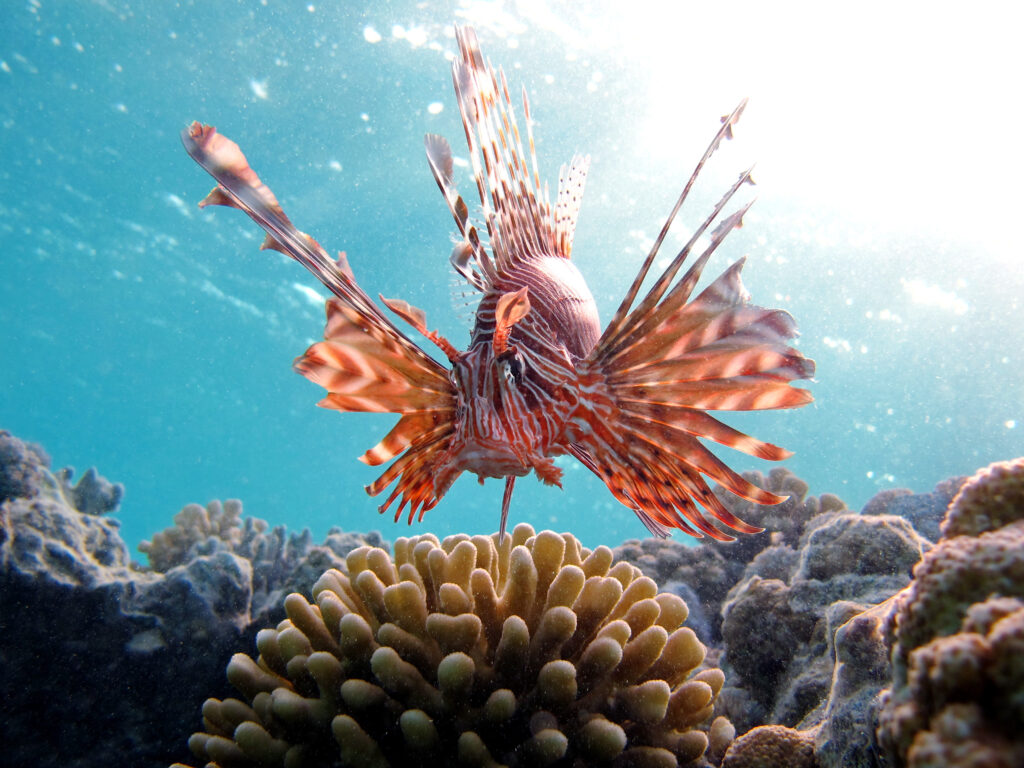With the world’s ocean covering over 70% of the Earth’s surface, there’s a huge variety of ecosystems and millions of years of evolution hiding in its depths. With that in mind, it’s no surprise that there’s a vast diversity of marine life – including some weird and wonderful creatures.
At Blue Reef Aquarium Newquay, we’re lucky enough to have some of these beautiful and intriguing animals at our aquarium. Let’s explore just some of the creatures you might spot on your next visit.
Xenopus frog
The African clawed frog (Xenopus laevis), sometimes simply called the Xenopus frog, is a fascinating creature. According to the University of Cambridge, this particular species is genetically similar to humans, which can be invaluable when it comes to learning more about our world!
However, unlike humans or other mammals, this amphibian’s offspring grow outside of its body, with opaque eggs that quickly become transparent.
The Xenopus frog typically lives in warm grassland ponds, usually covered in green algae. They are unique in appearance as they don’t have a tongue, or visible ears. This species also displays a flattened body and wedge-shaped head that’s smaller than the rest of it. Its front limbs are not webbed, instead resembling individual claws.
You can find this fascinating frog in our Tropical Rivers exhibit!
Spanish ribbed newts

The Spanish ribbed newt (Pleurodeles waltl), also known as the Iberian ribbed newt, is the largest European species. Typically found in Portugal, Spain and Morocco, they have an incredibly fascinating defence mechanism that you’re unlikely to see in other species.
The Spanish ribbed newt gains its name from this defence technique, as it can force its own ribs out through its skin! It does this by puncturing the skin, after which the newt can use the bones as a defensive weapon against threats. Even more interestingly, the Spanish ribbed newt is immune to its own toxin and also releases antimicrobials to help prevent any infection.
They are also able to secrete a toxic discharge; while this is only irritating on human contact, it can kill a mouse.
We’ve mimicked the Spanish ribbed newt’s natural habitat in our Tropical Rivers exhibit, so you can see it for yourself in all its glory!
Turbot
The turbot (Scophthalmus maximus) is a type of flatfish, creating a very unique appearance that is only enhanced even more by the fact that it has no scales. Instead, they have bony tubercles, or little knobbles.
They are a sinistral type of flatfish, which means that both their eyes are on the left side. You might think this means they have limited vision, but flatfish’s eyes are on the end of small stalks, so they have a little more peripheral vision than you think. Their eyes can also move independently.
Adult turbot typically live on sandy or rocky sea floors, including the Atlantic, Mediterranean Sea and Baltic Sea. They have the ability to camouflage against their environment, thanks to colour-changing cells known as melanophores.
Take a trip to the Rockpool exhibit if you’re interested in having a look for yourself!

Cuvier’s dwarf caiman
The Cuvier’s dwarf caiman (Paleosuchus palpebrosus) is part of the Alligatoridae family which comprises of caimans and alligators, closely related to the true crocodiles. The Cuvier’s dwarf caiman is known as a New World crocodilian, as are other species in its family.
It’s the smallest caiman, but still reaches sizes of around 1.5m. They are equipped with thick scales and bony plating, which means they only have a few predators brave enough to try their luck, including jaguars, anacodas and boa constrictors.
Cuvier’s dwarf caimans have incredibly powerful jaws to help them crush their prey, but they also have a special section to their stomach to help too. This is called the ‘gizzard’, and contains stones that the caiman swallows to help break down their meals!
These amazing reptiles are usually found in South America’s flooded forests, but you can see them for yourself in the Tropical Rivers exhibit.
Starfish
Starfish (Asteroidea) are also sometimes known as sea stars because technically they aren’t fish. They are echinoderms, a type of marine invertebrate. With their iconic star shape, these creatures are fascinating to observe.
There’s around 2,000 different species of starfish, and they live across all the world’s oceans – you’ll even find native UK species!

The most fascinating fact about starfish is their famous ability to regenerate limbs or even entire bodies. Some species will need their central body or disc to be intact in order to achieve this, but there are a few species that can generate a whole new body from just a part of a severed limb!
What’s more, starfish also consume their food outside of their bodies, as their stomach emerges out of their mouths before drawing back inside its body.
Be sure to visit the Rockpool exhibit to catch a glimpse of these extraordinary creatures.
Loggerhead turtle
Loggerhead turtles (Caretta caretta) are the largest species of hard-shelled turtles, named after their huge heads and strong jaws. They are highly migratory, travelling an enormous range across all but the coldest oceans.
The females will often return to the beach where they hatched themselves in order to lay their eggs, which can include travelling thousands of miles to do so.
The loggerhead turtle is known as a keystone species, which means it plays a valuable role in its ecosystem. Other animals in its habitat depend on it for survival. As the loggerhead eats invertebrates, the shells pass through their digestion system and fall to the bottom of the ocean for animals to eat. As is the circle of life, loggerhead hatchlings also provide a food source for predators while other animals live on their shells.
Our Ocean Tunnel exhibit provides an up-close view of this majestic creature as they glide through the water.
Stonefish
Stonefish (Synanceia) hold the title for the most venomous fish in the world. Their camouflage is so effective that they resemble rocks or coral, making them nearly invisible to both predators and prey.
These fish have venomous spines that can deliver a painful sting, but don’t worry – they typically save their spines for defence, and won’t go out of their way to attack! Stonefish feed on small fish and crustaceans, lying in wait and striking with their big jaws, swallowing their prey whole.
You can find these masters of disguise in our Tropical Marine exhibit.
Lionfish

Lionfish (Pterois) are beautiful marine fish, known for their striking striped appearance and venomous spines. Native to the Indo-Pacific, they are also now found in the Atlantic, Gulf of Mexico, and the Caribbean as an invasive species.
Lionfish are voracious predators, feeding on small fish and invertebrates. They have 18 dorsal fins which are needle-like in shape, but they are used purely for defence. Instead, they rely on camouflage and incredibly fast reflexes to catch their prey.
Visit the Warmer Waters exhibit to see these stunning fish.
Blacktip reef shark
Blacktip reef sharks (Carcharhinus melanopterus) are easily recognisable by the black tips on their fins. These agile predators are often found in shallow waters near coral reefs in the Indo-Pacific region.
The blacktip reef shark is known as a requiem shark, which means it is part of the Carcharhinidae family. They are characterised as migratory, live-bearing sharks that live in warm seas. Other species in this family include the bull shark (Carcharhinus leucas) and sand tiger shark (Carcharhinus taurus)!
They display something known as countershading, which is a type of colouration camouflage. Their dorsal (top) side is darker, which helps them blend in when viewed from above, while their underside is light to match the ocean’s brighter surface when viewed from below!
Our Ocean Tunnel exhibit offers a thrilling experience, allowing you to observe these dynamic sharks up close.
Sailfin lizard
Sailfin lizards (Hydrosaurus) are among the most visually striking reptiles, with their large dorsal fins and vibrant colouration. These semi-aquatic lizards are native to the Philippines and other parts of Southeast Asia.
Sailfin lizards are excellent swimmers and are often found near rivers and streams. They feed on a variety of plant and animal matter, making them omnivorous.
You can see these impressive lizards in our Tropical Rivers exhibit.
At Blue Reef Aquarium Newquay, we’re committed to showcasing the incredible diversity of marine life. Each exhibit is carefully curated to replicate the natural habitats of these amazing animals, providing an immersive and educational experience for visitors of all ages. Come and explore and discover the wonders of the underwater world by booking your tickets today!
